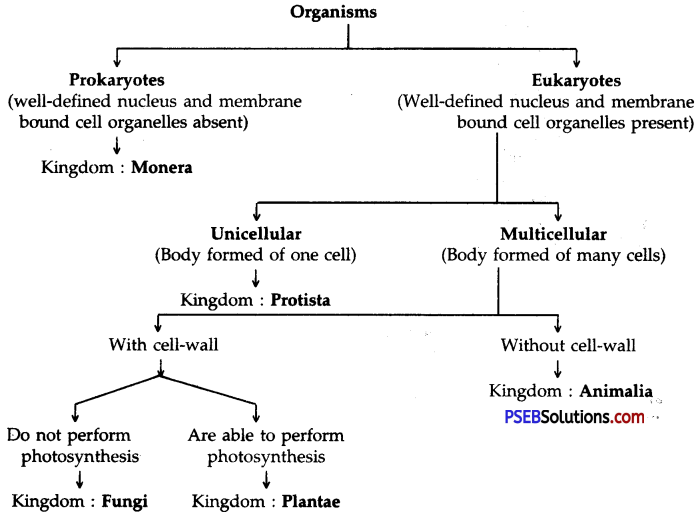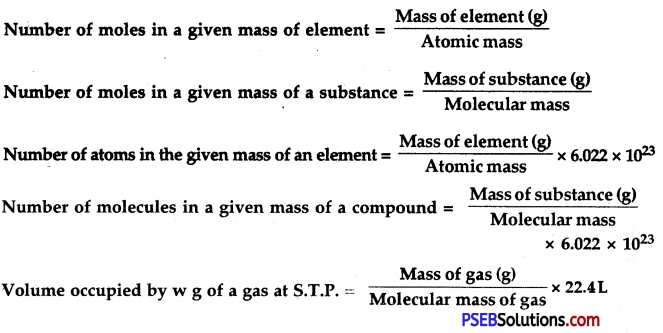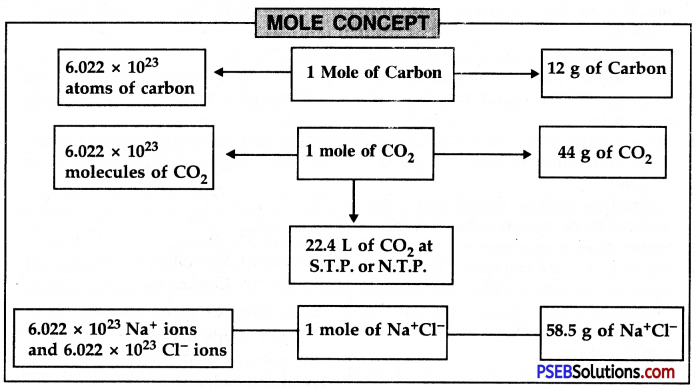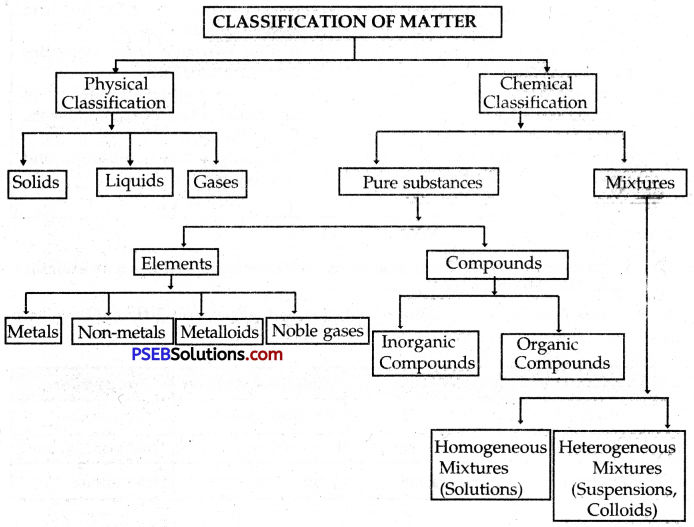This PSEB 9th Class Science Notes Chapter 7 Diversity in Living Organisms will help you in revision during exams.
PSEB 9th Class Science Notes Chapter 7 Diversity in Living Organisms
→ There are about 10 million living organisms present on earth and only 1/3rd of these organisms have been identified.
→ All organisms differ from each other in their structure.
→ The classification of organisms is arranging organisms into groups or sets on the basis of similarities and differences which also exhibit their relationships.
→ Each organism is different from all others to a lesser or greater extent.
![]()
→ The science of classification is called taxonomy.
→ Bacteria are microscopic of a few micrometres in size whereas blue whale and red Wood trees of California are of size 30 metres and 100 metres respectively.
→ Present-day diversity in living beings is the product of 3.5 billion years of organic evolution.
→ Carolus Linnaeus is the Father of Taxonomy.
→ Classification makes the study of a wide variety of organisms easy.
→ Classification helps us explore the diversity of life forms.
→ Linnaeus classified organisms on the basis of similarities and differences.
→ Binomial nomenclature was given by Linnaeus. Each organism is assigned two names, generic name, name of the genus, and specific name, of species.
→ In two-kingdom systems of classification, kingdom Plantae and kingdom Animalia were classified.
→ Plants are autotrophic, prepare their own food and plant cells have cell walls made up of cellulose. Divided into two groups crypto game and phanerogamae.
→ Animals lack chlorophyll and are heterotrophic in nutrition.
→ R. H. Whittaker (1969) proposed five kingdom systems of classification.
![]()
→ The five kingdoms are Monera, Protista, Fungi, Plantae, and Animalia.
→ Monerans lack well-defined nuclei and membrane-bound cell organelles.
→ This group includes bacteria, blue-green algae (cyanobacteria), and Mycoplasma.
→ Protists include unicellular eukaryotic organisms. Some may have specialized structures for moving such as cilia, flagella, or pseudopodia.
→ Agar, diatoms, and protozoans are examples.
→ Plantae and Animalia are further divided into subdivisions on the basis of increasing complexity.
→ Charles Darwin (1959) described the idea of evolution in his book, ‘The Origin of Species’.
→ ‘Primitive’ or ‘lower’ organisms have ancient body designs.
→ Advanced or higher organisms acquired their particular designs relatively recently.
→ Complexity in design increases over evolutionary time.
→ Biodiversity refers to a variety of life forms found in a particular region.
→ The warm and humid tropical regions of the earth are rich in diversity of plant and animal life. The region is called the region of megadiversity.
→ Ernst Haeckel (1894), Robert Whittaker (1959), and Carl Woese (1977) have tried to classify all living organisms into broad categories, called Kingdoms.
![]()
→ Aristotle classified animals according to their habitat (land or water).
→ Basis of classification
- Nature of cell Prokaryotic or eukaryotic cell.
- The number of cells Single-cell or multicellular.
- Method of preparing food
- Plants carry out photosynthesis thus autotrophs.
- Fungi absorb food, thus absorptive.
- Animals have an ingestive (holozoic) modes of feeding.

Classification of Kingdom Animalia:
→ Protozoa are included in Protista, include single-celled, aquatic, free-living or parasitic organisms.
Examples: Amoeba, Paramecium, Euglena.
→ Phylum Porifera era includes pore-bearing organisms called sponges which are the simplest multicellular animals.
→ Sponges are vase-like, rounded, sac-like, or branched. Euplectella, Sycon, Spongilla, Bath sponge are examples.
→ Phylum Cnidaria is a diploblastic radially symmetrical animal with two-layered body walls.
Examples: Hydra, Jellyfish, Sea anemone, and Corals.
→ In Phylum Platyhelminthes, flatworms have been included which are mostly parasitic.
Examples: Dugesia, Liver fluke, Tapeworm.
![]()
→ Round or threadworms are included in Phylum Aschelminthes which are triploblastic, unsegmented, and of bilateral symmetry. Example: Ascaris.
→ Annelids are triploblastic, bilaterally symmetrically elongated with segmented bodies.
Examples: Earthworm, Leech, Nereis.
→ Animals with jointed legs have been placed in Phylum Arthropoda. These animals’ body is covered with chitinous cuticle.
Examples: It is the largest phylum and includes prawns, insects, spiders, scorpions, etc.
→ In Phylum Mollusca, the body is divided into three regions i.e. head, a dorsal visceral mass, and ventral foot. These are soft-bodied animals.
Examples: Pila, Unio.
→ Phylum Echinodermata includes starfishes, brittle stars, and sea urchins. These are spiny-skinned.
Examples: Starfish, Sea lily
→ In Phylum Hemichordata, the body is divided into three parts i.e. proboscis, collar, and trunk.
Examples: Balanoglossus.
→ Phylum Chordata represents the most advanced group of kingdom Animalia.
→ Protochordate group includes Herdmania and Amphioxus.
→ Chordates bear
- a solid rod-like structure called the notochord, on the dorsal side above the gut
- dorsal hollow nervous system
- pharynx, perforated by gill slits
→ Systematics: It is the study of the diversity of organisms and all their comparative and evolutionary relationship.
![]()
→ Taxonomy: It deals with the identification, nomenclature, and classification of different types of organisms.
→ Species: A group of living organisms of similar individuals capable of exchanging genes and interbreeding. The species is ranked below a genus.
Example: Homo sapiens.
→ Fertilization: Fusion of male gamete and female gamete is called fertilization.
→ Classification: It is the arrangement of organisms into groups on the basis of similarities and differences.
→ Binomial Nomenclature: Every organism is given a scientific name that has two parts, the first is the name of the genus (generic name) and the second is the name of the species (specific name).
→ Dicotyledonous: Plant having seeds with two cotyledons.
→ Ovule: A structure in the ovary of a seed plant that develops into a seed following fertilization.
→ Gametophyte: The haploid generation producing gametes in plants.
→ Annuals: A plant that completes its life cycle in one growing season.
→ Mycelium: A mass of filament or hyphae, composing the vegetative part of many fungi.
→ Hyphae: One of the filaments composing mycelium.
→ Saprophyte: A plant that lives on decaying organic matter.
→ Notochord: An elongated dorsal cord which is the primitive axial skeleton of chordates.
![]()
→ Aerobe: An organism that can grow and live in the presence of oxygen.
→ Nocturnal: Active during night e.g. cockroach.
→ Polygamy: When one male lives in the company of many females e.g. Struthio.
→ Producers: The first trophic level in a food chain. Producers are those organisms that can prepare food from inorganic materials i.e. green plants.





